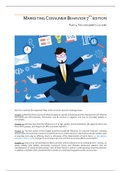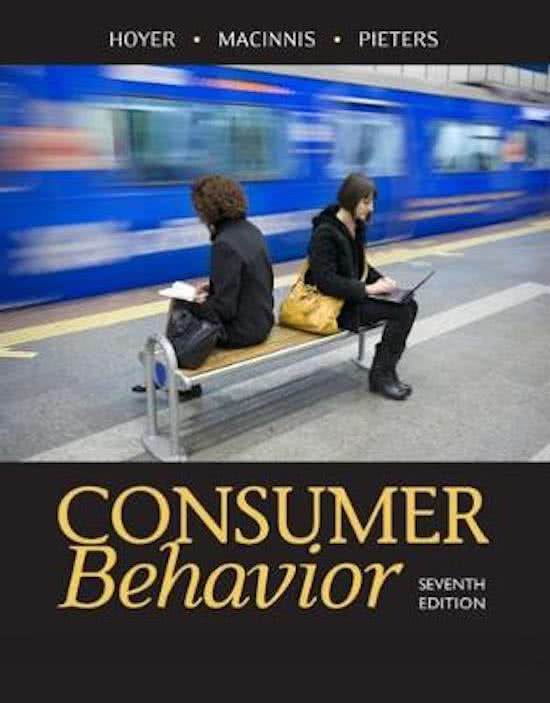MARKETING CONSUMER BEHAVIOR 7TH EDITION
PART 4 THE CONSUMER’S CULTURE
Part four examines the sequential steps in the consumer decision-making process.
Chapter 11 describes three sources of influence (general, special, and groups) and the characteristics of influence
(normative and informational). Information may be positive or negative, and may be provided verbally or
nonverbally.
Chapter 12 examines how diversity influences such as age, gender, sexual orientation, the region in which one
lives, ethnic groups, and religion can affect consumer behavior.
Chapter 13. The first section of this chapter examines household influences on consumer behavior, including
various types of households, trends in household structure, and the decision roles that household members play
in acquiring and using an offering. Next is a discussion of the determinants of social class (e.g. occupation,
education, and income), changes in social class over time, and how social class affects consumption.
Chapter 14 looks at how membership the effects of these cultural influences on an individual level – namely, on
values (deeply held beliefs), personality (consumer traits), and lifestyles (behavioral patterns that are
manifestations of values and personality). Each of these factors is useful in understanding consumer behavior;
in addition, marketers often combine them to obtain an overall psychographic profile of consumers.
,CHAPTER 11: SOCIAL INFLUENCES ON CONSUMER BEHAVIOR
11.1 S OURCES OF INFLUENCE
Marketing source: Influence delivered from a marketing agent, for example, advertising, personal selling.
Nonmarketing source: Influence delivered from an entity outside a marketing organization, for example,
friends, family, and the media.
Word of mouth: Influence delivered verbally from one person to another person or group of people.
Opinion leader: An individual who acts as an information broker between the mass media and the opinions
and behaviors of an individual or group.
Gatekeeper: A source that controls the flow of information.
Market maven: A consumer on whom others rely for information about the marketplace in general.
Many people learn about products through advertising, Facebook, Instagram, e-mail, personal experience,
and other sources. Building buzz can be effective because it uses the influence of third parties to amplify initial
marketing efforts. But which sources have the most impact, and why?
M ARKETING AND NONMARKETING SOURCES
Influence from (non)marketing sources can be delivered via the mass media or personally.
M ARKETING SOURCES DELIVERED VIA MASS MEDIA
Marketing sources that deliver influence through the mass media include advertising, sales promotions,
publicity, special events, and social media posts from companies.
M ARKETING SOURCES DELIVERED PERSONALLY
Salespeople, service representatives, and customer service agents are marketing sources of influence who
deliver information personally. Sponsored content can be posted by blogs who are payed companies and blur
the line between marketing and nonmarketing sources.
N ONMARKETING SOURCES DELIVERED VIA MASS MEDIA
Sources that are not working for marketing companies (nonmarketing sources) can also wield influence via mass
media-delivered messages. Consumer behavior may be affected by news items about new products, movies,
and restaurants; accidents involving products; and incidences of product abuse. Consumers can also be
influenced by reviews, consumer reports, recommendations and other information not controlled by marketers.
N ONMARKETING SOURCES DELIVERED PERSONALLY
Finally, consumer behavior is influenced by nonmarketing sources who deliver information personally. Our
consumer behavior can be affected by observing how others behave or by word of mouth, information about
offerings, communicated verbally by friends, family, neighbors, casual acquaintances, and even strangers.
M ARKETING AND NONMARKETING SOURCES
DELIVERED VIA SOCIAL MEDIA
Social media platforms such as Facebook, YouTube,
and Instagram, are increasingly used by marketing
and nonmarketing sources. Social media have a mass
reach, but a more personal feel because consumers
choose when, where, and how to access and share
the content. E.g. Super Bowl ads regularly go viral
and attract millions of viewers within a very short
time period.
2
, H OW DO THESE GENERAL SOURCES DIFFER ?
The influence sources differ in terms of their reach, capacity for two-way communication, and credibility. In
turn, these characteristics affect how much influence each source can have with consumers.
• Reach.
Mass media sources are important to marketers because they reach large consumer audiences and
thus expanding marketers’ reach dramatically.
• Capacity for two-way communication
Personally delivered sources of influence are valuable because they allow for a two-way flow of
information. E.g. A car salesperson may have more influence than a car ad because the salesperson
can tailor sales information to fit the buyer’s information needs, rebut counterarguments, and answer
the buyer’s question.
• Credibility
Consumers tend to perceive information delivered through marketing sources as being less credible,
more biased, and manipulative. In contrast, nonmarketing sources appear more credible.
O PINION LEADERS
A special source of social influence is the opinion leader, someone who acts as an information broker between
the mass media and the opinions and behaviors of an individual or group. These opinion leaders have some
position, expertise, or firsthand knowledge that makes them important sources of relevant and credible
information, usually in a specific domain or product category. E.g. Cristiano Ronaldo is an opinion leader for
football shoes (which is why Nike pays him for endorsing their products). They are not necessarily well-known
people; they may be friends, acquaintances or professionals like doctors, dentists, or lawyers.
Opinion leaders are part of a general category of gatekeepers, people who have special influence or power in
deciding whether a product or information will be disseminated to a market.
A market maven, someone who seems to have a lot of information about the marketplace in general, can also
be identified. They seem to know all about the best products, the good sales, and the best stores or retail
websites.
11.2 R EFERENCE GROUPS AS SOURCES OF INFLUENCE
Associative reference group: A group to which we currently belong.
Aspirational reference group: A group that we admire and desire to be like.
Brand community: A specialized group of consumers with a structured set of relationships involving a
particular brand, fellow customers of that brand, and the product in use.
Dissociative reference group: A group we do not want to emulate.
Primary reference group: Group with whom we have physical face-to-face interaction.
Secondary reference group: Group with whom we do not have direct contact.
Homophily: The overall similarity among members in the social system.
Tie-strength: The extent to which a close intimate relationship connects people.
Embedded market: Market in which the social relationships among buyers and sellers change the way the
market operates.
Consumer socialization: The process by which we learn to become consumers.
A reference group is a set of people with whom individuals compare themselves for guidance in developing
their own attitudes, knowledge, and/or behaviors.
3






